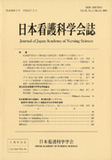Japanese
English
- 販売していません
- Abstract 文献概要
- 参考文献 Reference
要旨
本研究の目的は,リスクマネジメントの視点から療養の場における物理的環境特性の一つである照明条件が,色の弁別に及ぼす影響を明らかにすることである.対象は,視力が0.8以上の女性で平均年齢24.2歳(標準偏差3.2歳)の25名である.実験条件は,光源に色比較・検査用D65蛍光ランプと白熱灯を使用し,照度を1,000,500,200,100,50,30,10lxに設定した.提示色表の「ランドルト環色─背景色」の組み合わせは,「赤─しろ」,「赤─だいだい」,「赤─あお」,規準色の「黒─しろ」とした.赤は血液の色,背景色は臨床で使用するリネン類の色である.その結果,照度基準の1,000lxと比較した場合,「赤─だいだい」で白熱灯照明下および100,50,30,10lxで正答数が有意に低下した(p<0.05, p<0.001, p<0.001, p<0.001).従って,観察をする時には,200~1,000lxの照度が確保できる移動可能な補助ライトや相関色温度が高く色の弁別の誤りが少ない光源を使用することで,色の弁別をしやすくすることが示唆された.
Abstract
The purpose of this study was to identify which factors in lighting conditions affect discrimination of color in a clinical context. The subjects were 25 females (mean age 24.2 years old, SD 3.2) with visual acuity of 0.8 or higher. The experimental conditions comprised two light sources, a D65 color fluorescent lamp and an incandescent lamp, used at light levels of 1,000, 500, 200, 100, 50, 30, and 10 lx. Colored Landolt's rings placed against colored backgrounds were used to test color discrimination at these different light levels. As seen in the presentation color tables, the colors used were “RED-white”,“RED-orange”, and “RED-blue”, plus the standard “BLACK-white”. RED is the color of blood, and the background colors are the colors of clinically used linens. The results showed a significant increase in the rate of incorrect answers when an incandescent lamp was used to illuminate the “RED-orange” presentation color table at 100, 50, 30, and 10 lx, compared with the recommended 1000 lx level of illumination (p<0.05, p<0.001, p<0.001, p<0.001). The experimental results suggest that when observing patients, the use of a portable auxiliary light providing illumination of 200-1,000 lx or a light source with a higher color temperature would lead to fewer errors in color discrimination.
Copyright © 2003, Japan Academy of Nursing Science. All rights reserved.


